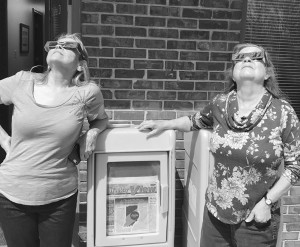At 3 p.m. on April 8, Paula, her brother Mark, and I set up chairs in the empty parking lot of our office at 195 N. Shortridge Rd. Through special glasses, we watched as the moon slowly nibbled away at the sun, inching the way to darkness. The air grew cooler, and turned that odd color it does when a big storm is moving in as the last sliver of sun dangled in the sky. Then it blipped out, and there, in the middle of the afternoon, it was dark as night. Planets and stars appeared in the sky, and the horizon looked like twilight. After three minutes and 45 seconds, the sun reappeared, and everything seemed to go back to “normal.” We went back to work on the April 12 issue, though I couldn’t help thinking about that experience for quite a while.
For those few minutes, I was struck with the smallness of human beings as we were swallowed up in the brief night. The sun, our local star is massive beyond belief, but the moon, our tiny satellite, managed to blot it out for a time. The precise alignment of what we think of our planet, our sun, our moon, made this phenomenon, and we just happened to be in the right place and right time to witness it. One day, billions of years from now, our sun will be no more, and our earth will be no more, and everything we think we know and hope to know will disappear.
The total eclipse was hyped up all along the path of totality, and news reports flooded in about traffic jams, price gouging on hotel rooms, high gas prices, rest areas along highways packed with watchers, and much more. Indianapolis, a city used to handling large crowds efficiently, did a great job keeping things moving and unjammed up around the big events. We owe our first responders a round of thanks for being on the job and keeping the peace during this once-in-a-lifetime event.
The next time we will be able to see a total eclipse over Indianapolis will be in 2153, and I’m pretty confident that most of us will not be around for it. Scientists will study this eclipse for years, as they try to further our understanding of our solar system. There will be two more eclipses in 2024 — a partial eclipse of the moon on Sept. 17 at 8:39 p.m. ET that will be visible in most of North America, and an annular solar eclipse on Oct. 2 that will not be visible in the United States. The next total eclipse viewable in Indiana will be in 2044, and will only be visible in the south of the state.



